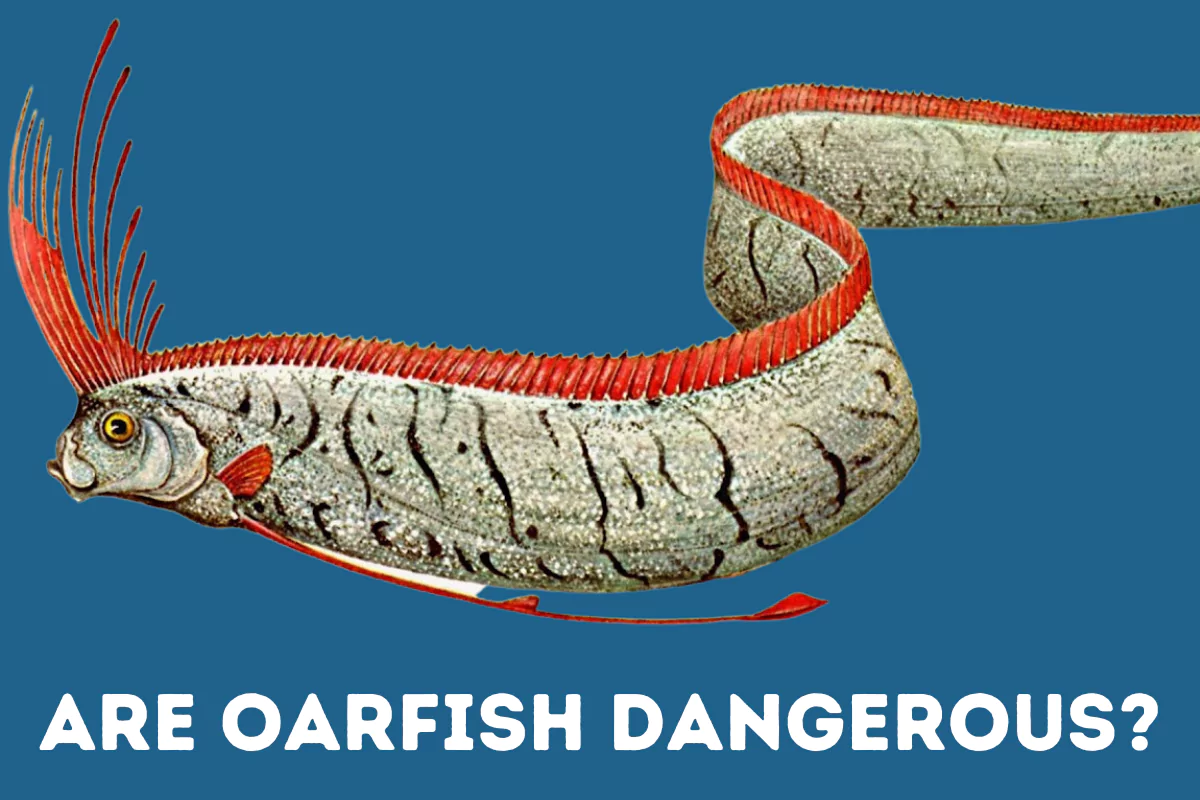Oarfish are known to many people as sea monsters due to their gigantic structures. They are the longest-known living species of bony fish, with a length of around 56 feet (17 meters) and weighing up to 600 pounds (270 kilograms).
As they live in deep water and are rarely seen at the surface, very little information is known about them. So many people are curious to know more about them at every opportunity they get, and this article serves that very purpose.
Are Oarfish Dangerous?
Many believe that they are thought to be the inspiration for “sea serpent” tales of old. The giant oarfish (Regalecus glesne) was first mentioned in 1772, but it has been rarely seen because it lives at considerable depths. It is said and thought to be that they live at depths of around 3,300 feet (1,000 meters).
These silvery fish are sometimes called the “king of herrings” because of their superficial resemblance to the smaller fish, but they are named oarfish due to their long pectoral fins, which closely resemble oars.
Despite their size and all the stories that are added to these massive beings, oarfish are not dangerous. In fact, they are considered harmless and friendly marine creatures. It is quite natural to assume they are dangerous, but in reality, they aren’t dangerous at all.
As we discussed already, oarfish can be the source of many historical tales of sea serpents and sea monsters as they live deep inside the ocean and have rarely been observed alive. There is no information about them even in this modern era, let alone ancient times with timber boats.
Oarfish have been (mis)judged by their huge body structure, and some started calling them sea monsters. Their rare appearance of them also added some spice to this myth!
Even today, people tend to believe in those stories and consider Oarfish dangerous, but we can say that there isn’t even a single case of people getting hurt by Oarfish!
Also Read: Are Sunfish Dangerous?
Do Oarfish Attack Humans?
Most of the time, when oarfish make their appearance, they are either injured or already dead. There are very few occasions when they are seen alive. Scientists think that the reason oarfish come to the surface is that they are pushed there by sea storms or strong ocean currents.
There has been very little research conducted on Oarfish compared to other marine creatures. So, there is very little information about their behavior and habitat as of today.

When there is a blank, it is human tendency to fill it up with something, so that can be reasoned with so many judgemental stories, including mythical analogies. Despite being the world’s longest bony fish, oarfish are not dangerous and never attack humans, as per our data.
Note: Despite being the probable reason for the source of many historical tales of sea serpents and sea monsters, Oarfish are hardly dangerous to people. However, they might and can sometimes attack people in self-defense. So if you ever encounter an oarfish at the beach or any place, it’s recommended not to go near them and maintain a safe distance.
Can We Eat Oarfish?
According to the National Oceanic and Atmospheric Administration (NOAA) website, people have tried eating them in the past but found that the oarfish flesh is flabby and gooey. They taste like gelatinous goo.
Also Read: Are Swordfish Dangerous?
What do Oarfish Eat?
Giant oarfish eat tiny plankton and aren’t dangerous. Oarfish don’t even have real teeth, but they have flimsier structures called ‘gill rakers’ to catch tiny organisms, and they have a small opening to their digestive system.
Can Oarfish Bite?
As we discussed, oarfish have no real teeth, so the question comes, can they bite?
No, oarfish cannot bite for not having teeth. They use the ‘gill raker’ (the special duct in their mouth) to catch small prey and eat them. But still, even the tiny movement of their tail or fins, or to say any part of their body, can harm you due to their gigantic size. So, it’s always advisable to keep some distance from them if you ever spot any.
Can Oarfish Predict Earthquakes?
The oarfish is the world’s longest bony fish, and they have been said to forecast earthquakes. In Japan, they have long figured into folklore. There, the slender oarfish (Regalecus russelii), which is smaller than the giant oarfish, is known as the “Messenger from the sea god’s palace,” and according to traditional belief, if many of the fish wash up, it may signal an upcoming earthquake.
The ‘Japanese Times’ published that there could be some scientific basis to this story even though currently, scientists don’t use fish behavior to predict tremors.
Kiyoshi Wadatsumi, a scientist who studies earthquakes at the e-PISCO (a nonprofit organization), commented, “Deep-sea fish living near the sea bottom are much more sensitive to the movements of active faults than those near the surface of the sea.”(1)
Some Interesting Facts About Oarfish:
- In 2000, oarfish was featured on a stamp in Palau.
- They are called roosterfish by some because of their slender, reddish fin. Some people also call them ribbonfish due to their body form.
- Oarfish don’t have scales on their body, unlike other bony fish. Rather, they have tubercules and a silvery coat of a material called ‘guanine.’ Although they are adapted to survive under high pressure, having no scales makes their skin soft and can be easily damaged at the surface.








